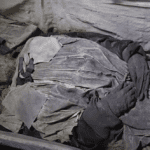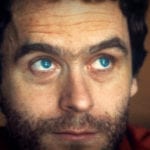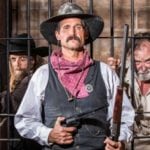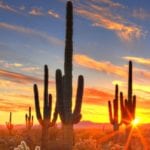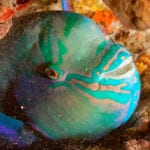 Technology
Technology  Technology
Technology  Humans
Humans 10 Everyday Human Behaviors That Are Actually Survival Instincts
 Animals
Animals 10 Animals That Humiliated and Harmed Historical Leaders
 History
History 10 Most Influential Protests in Modern History
 Creepy
Creepy 10 More Representations of Death from Myth, Legend, and Folktale
 Technology
Technology 10 Scientific Breakthroughs of 2025 That’ll Change Everything
 Our World
Our World 10 Ways Icelandic Culture Makes Other Countries Look Boring
 Misconceptions
Misconceptions 10 Common Misconceptions About the Victorian Era
 Mysteries
Mysteries 10 Strange Unexplained Mysteries of 2025
 Miscellaneous
Miscellaneous 10 of History’s Most Bell-Ringing Finishing Moves
 Technology
Technology Top 10 Everyday Tech Buzzwords That Hide a Darker Past
 Humans
Humans 10 Everyday Human Behaviors That Are Actually Survival Instincts
 Animals
Animals 10 Animals That Humiliated and Harmed Historical Leaders
Who's Behind Listverse?

Jamie Frater
Head Editor
Jamie founded Listverse due to an insatiable desire to share fascinating, obscure, and bizarre facts. He has been a guest speaker on numerous national radio and television stations and is a five time published author.
More About Us History
History 10 Most Influential Protests in Modern History
 Creepy
Creepy 10 More Representations of Death from Myth, Legend, and Folktale
 Technology
Technology 10 Scientific Breakthroughs of 2025 That’ll Change Everything
 Our World
Our World 10 Ways Icelandic Culture Makes Other Countries Look Boring
 Misconceptions
Misconceptions 10 Common Misconceptions About the Victorian Era
 Mysteries
Mysteries 10 Strange Unexplained Mysteries of 2025
 Miscellaneous
Miscellaneous 10 of History’s Most Bell-Ringing Finishing Moves
10 Untold Stories From The Wild Days Of The Beatles
In just a few short years, The Beatles created the most iconic albums of all time, changing music and pop culture forever. And while they recorded their greatest hits, the four lads from Liverpool were living out some of rock and roll’s craziest stories. From their first American tour to their troubled last days, The Beatles were constantly cooking up the strangest plans, meeting the most interesting people, and winding up in the weirdest places.
10The Jelly Bean Incident
When The Beatles arrived in America in 1964, they sparked a wild tide of mass hysteria that we all know as Beatlemania. Over 75 million people tuned in to watch their performance on The Ed Sullivan Show, and when they showed up in Washington, D.C., they had to rent the entire seventh floor of the Shoreham Hotel to escape their frenzied fans.
During their 34-day tour, the band played at Carnegie Hall and San Francisco’s Cow Palace, but perhaps their most painful performance was at the Coliseum in D.C. A boxing arena, the stage was set in the middle of the auditorium, meaning the boys were surrounded. Throughout the gig, they had to turn around continually so everyone could glimpse their faces. That meant Ringo had to get up between songs and drag his kit around by himself.
Then fans brought out the jelly beans.
Before their performance, The Beatles had been interviewed by the New York Times, and George made a comment about how much he liked “jelly babies.” Eager to please, starstruck fans loaded their pockets with jelly beans and hurled them at the stage, hitting the band from every side. The candies hit their guitar strings, pinged against Ringo’s cymbals, and smacked the performers in the face.
There’d been a major misunderstanding. Jelly beans aren’t jelly babies. Babies are soft (the US equivalent would be gummi bears), while beans are pretty hard. George was worried he might go blind. “It’s a bit dangerous, you know,” he once said, “because if a jelly bean, traveling about 50 miles an hour through the air, hits you in the eye, you’re finished.” Fortunately, the boys made it through, battered but alive, and went on to play another day.
One of the few men in the audience that evening was future vice president Al Gore. He claims that he didn’t throw any jelly beans.
9Jimmie Nicol’s 10-Day Drumming Gig
Beatles fans love to debate the identity of the “Fifth Beatle,” that unofficial member who helped push the band to greatness. Some say it’s original drummer Pete Best. Others point to Stuart Sutcliffe, the first Beatles’ bassist. Still other contenders for the title are manager Brian Epstein, producer George Martin, and “Let It Be” pianist Billy Preston. But perhaps the best candidate for fifth Beatle is Jimmie Nicol, the man who replaced Ringo.
Nicol was a 24-year-old drummer and the head of his own band, The Shubdubs. But one day in June 1964, he got a call from Brian Epstein. Ringo was sick with tonsillitis, and the band was about to go on tour. Epstein couldn’t cancel, so he was wondering if Jimmie was interested in filling Starr’s shoes.
Jimmie jumped at the chance, but there were a few snags. George opposed the plan—and Ringo’s pants were too short for the new drummer. But a couple of arguments, one audition, and a moptop haircut later, Nicol was touring with the world’s most famous band. They performed in Australia, Holland, Denmark, and Hong Kong. Everywhere Nicol went, he was mobbed by screaming girls. True, when he was on his own, no one recognized him. But with John, Paul, and George by his side, Nicol was a superstar.
As for poor Ringo, he was back in England, sitting in a hospital bed, feeling down in the dumps. “They’d taken Jimmie Nicol, and I thought they didn’t love me anymore,” he said. Then Paul sent Ringo a “get well” card, and 10 days later, Richard Starkey was feeling better and ready to rock. On his final night on tour, Jimmie was given a £500 bonus and a gold watch. Then he caught a plane back to England, and his glory days were done.
Nicol’s post-Beatles career was less than impressive. His band, The Shubdubs, didn’t do very well, and by 1965, he was bankrupt. He quit the music scene in ’67, and in recent years, he’s vanished from the face of the Earth. He’s supposedly living in London, but Nicol’s own son isn’t sure if he’s alive or not.
But Nicol’s influence has outlasted his reputation. Back on his 10-day tour, the guys would occasionally ask Jimmie how he was getting along. His stock answer was, “It’s getting better.” Inspired, Paul and John took his catchphrase and turned it into their Sgt. Pepper song “Getting Better.”
8The Great Beatles Relay Race
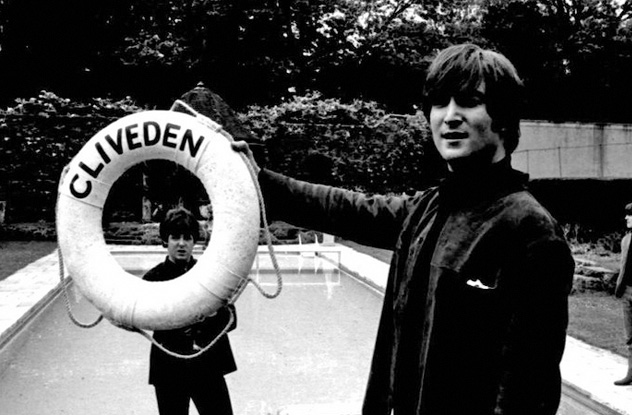
The Beatles knew a thing or two about music, but even the biggest Beatlemaniac will admit the Fab Four weren’t all that athletic. According to biographer Bob Spitz, there was a time when The Beatles smoked hundreds of cigarettes a day. While it didn’t seem to affect their voices, all that tar and nicotine took their toll on their health. George Harrison even admitted that all those cigs contributed to his fatal lung cancer.
Regardless of their personal habits, The Beatles were eager to show off their sporting skills on the set of their 1965 film Help! It was the boys’ last day on set, filming at Cliveden House, a 19th-century mansion in Maidenhead, Berkshire. When the four weren’t filming, they were goofing off and playing softball, until someone on the crew challenged them to a relay race.
The setup was simple. There were four teams, each one made of six men. The teams were divided into four groups: electricians, carpenters, the camera crew, and the Fab Four. Rounding out The Beatles’ team were their road manager and their chauffeur, and when somebody shouted “go,” the sprinters took off, tearing their way around the Cliveden House and through the garden.
According to Paul, the runners covered at least a mile, and believe it or not, The Beatles won. And thanks to a visiting American DJ who brought along a camera, you can see some of the race for yourself on the Help! DVD.
7When The Beatles Met Elvis
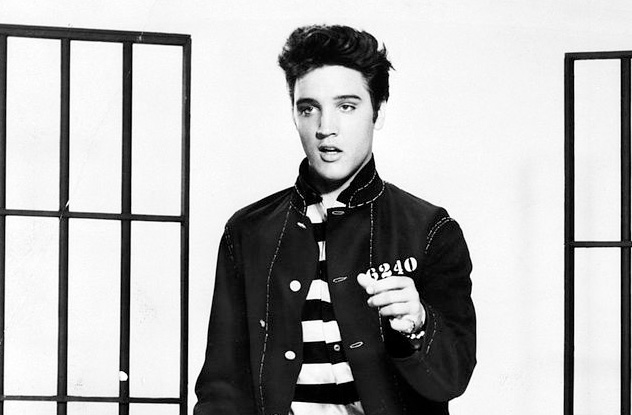
As big-time celebrities, The Beatles got to meet quite a few famous people. In 1964, they posed for photos with soon-to-be-champion Cassius Clay, who eventually changed his name to Muhammad Ali. That same year, Bob Dylan introduced the boys to marijuana, one of the more iconic events in Beatles lore. But perhaps the most interesting meet-up took place in 1965, when The Beatles visited the King of Rock and Roll himself, Elvis Presley.
This was a pretty big deal for John Lennon. As a boy, John had been an Elvis groupie, complete with Presley hair, long sideburns, and a poster of the King on his bedroom wall. He even once said that if it wasn’t for Elvis, “I wouldn’t be here.” The first time the two legends interacted was right after The Beatles’ performance on “The Ed Sullivan Show.” The King sent a congratulatory telegram, but the rockers didn’t actually meet until the Beatles’ second American tour.
The party was held at Elvis’s Bel Air mansion, and unfortunately for fans, cameras and microphones weren’t allowed inside. When The Beatles finally showed up for the big meet, things began awkwardly. The Brits weren’t sure what to say, and John started the conversation with a half-kidding insult, asking Elvis why he was making so many stupid movies instead of recording new material. “What happened to good old rock and roll?” he asked.
Presley wasn’t too offended and even managed to ease the tension when he said, “If you guys are just going to sit around and stare at me, I’m going to bed.” With the ice broken, everyone loosened up and had a better time. John and Elvis talked about Dr. Strangelove, while George smoked weed with one of the Memphis Mafia. Elvis’s manager, Colonel Parker, operated a craps table and a roulette wheel, and the King played pool with Ringo. Elvis eventually whipped out a few guitars for an impromptu jam session.
Four hours later, the meeting was over. The Beatles returned to their apartments, and they never met Elvis again.
Elvis eventually turned his back on the band. In 1971, he requested a meeting with J. Edgar Hoover, claiming that he wanted to work as an FBI informant and rat out subversives in the entertainment industry. At the top of his hit list were The Beatles, who’d “laid the groundwork for many of the problems we are having with young people by their filthy, unkempt appearance and suggestive music.”
The head of the FBI declined Elvis’s assistance.
6Back In The USSR
In 1966, after John made his infamous “more popular than Jesus” quip, angry Americans rampaged, bashing and burning piles of Beatles albums. And conspiracy theories abound, lambasting the boys from Liverpool for connections with the Illuminati.
However, nobody feared The Beatles more than the Soviet government. Recognizing their rebellious attitudes and Western ways as a threat, the USSR banned the sale of Beatles albums and punished anyone caught listening to this “capitalist pollution.” This only created a black market for contraband albums.
Like many illegal items, Beatles records were smuggled into Russia by sailors, actors, and the occasional Party official. The albums were then sold for a hefty price. Vinyl discs could cost Soviet citizens up to two weeks of their hard-earned paychecks.
Some enterprising outlaws devised an ingenious solution: etch the music onto X-ray film with the help of a modified record player. These jerry-rigged disks were covered in images of fractured arms and cracked pelvises, causing fans to refer to the albums as “music on the bones” or “records on ribs.”
Other musicians received the X-ray treatment, but there was something special about The Beatles. According to Mikhail Safonov of the Institute of Russian History, “Beatlemania washed away the foundations of Soviet society. The Beatles brought us the idea of democracy.” Inspired by the Fab Four’s fashion sense, teens used army boots and hand-me-down coats to copy the Beatles’ signature collarless look. Men grew their hair long, kids started their own rock bands, and anyone who challenged The Beatles was viewed with disdain—even government officials.
The state fought back as hard as it could. Students caught listening to The Beatles could be expelled from college. One Russian school put the band on trial and broadcasted the little drama for all the USSR to hear. And anyone sporting a moptop could be nabbed by the police and given a quick haircut. But despite all these efforts, The Beatles remained.
The USSR collapsed, and Paul McCartney played his first performance in Moscow in 2003.
5They Wanted To Buy An Island
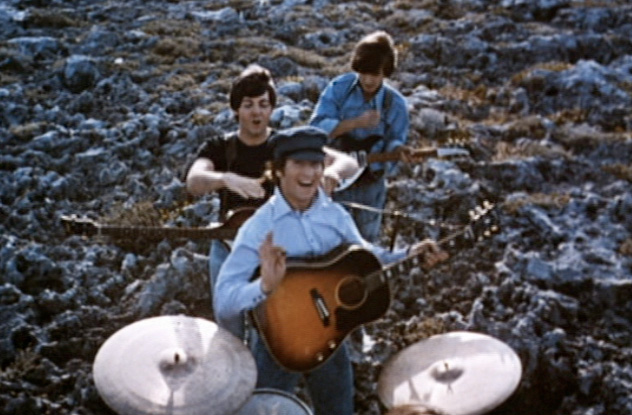
In 1967, The Beatles planned to sail to Greece, find a suitable island, and set up a Beatletopia. They’d build four houses, all connected at the center by a glass-domed recording studio/entertainment complex. The island would also have homes for members of their inner circle.
It was a wild plan, and it was John’s idea. Tired of English weather and crazy fans, Lennon wanted a place where he and his friends could live in peace. Paul, on the other hand, had a different take on the situation. “I suppose,” he once said, “the main motivation . . . would probably be that no one could stop you smoking.”
Dreaming of rest and recreational drugs, The Beatles flew to Greece, rented a yacht, and searched for their new home. As they cruised the Mediterranean, the boys dropped quite a bit of acid, and John and George spent a lot of time playing ukuleles. So they could sneak their LSD into the country, Magic Alex—their Greek friend and the eventual head of Apple Electronics—cut a deal with the Greek government. In exchange for a photo op with the Ministry of Tourism, The Beatles received diplomatic immunity.
The band found a spot to their liking, a guitar-shaped island called Leslo, which doesn’t exist on any map. They sent one of their assistants to buy the island, but by the time they got their money out of the UK, The Beatles had lost interest in their Greek getaway. Evidently, this was par for the course with The Beatles. According to McCartney, they once considered buying a little English village, but they dropped that idea, too.
Really, it’s a shame that the deal never went through as The Beatles were about to fall apart. Perhaps an island getaway could’ve saved their friendship. Of course, it might’ve smudged their “peace and love” personas, as Greece was ruled by a fascist dictatorship at the time.
4The Short-Lived Apple Boutique
After the death of manager Brian Epstein, The Beatles took their musical empire in a new direction. Wanting more say in financial matters, they established Apple Corps, a company that branched into several divisions like Apple Records, Apple Films, and Apple Electronics. The Beatles were also interested in retail, so in December 1967, they opened the Apple Boutique, a strange little store at 94 Baker Street in London.
Paul described the shop as “a beautiful place where beautiful people can buy beautiful things.” While musicians like James Taylor recorded songs upstairs or in the basement, fans could shop for goods on the ground floor. The merchandise was created by a Dutch design collective called The Fool, and they painted the storefront with a psychedelic rainbow mural, complete with stars, planets, and a yin-yang. The locals didn’t care for the artwork, and the city council had it painted over.
The Boutique didn’t do so well. For all their musical savvy, The Beatles were lousy businessmen. Their merchandise was garbage, and official “house hippie” Richard DiLello described the shop as “a bog of bad taste.” In fact, the store was losing money so fast that seven months after opening, The Beatles gave all their goods away for free. That was a rather hectic last day.
The closing of the Apple Boutique resulted in one last scandal. Wanting to publicize their upcoming single, Paul whitewashed the window and wrote “Hey Jude” in huge letters. The rest of the neighborhood misinterpreted his message. Since the band hadn’t released the song yet, everyone assumed it was a reference to the Nazi habit of scrawling “Juden” on stores owned by Jews. Local shopkeepers were furious, and somebody even put a brick through the window before The Beatles could clear up the mistake.
3Their On-Staff Astrologer
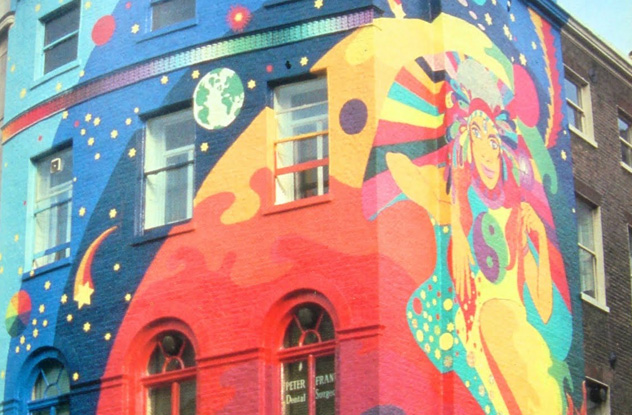
Before we leave the Apple Boutique behind, we should mention the store’s weirdest employee. His name was Caleb Ashburton-Dunning, he was the store’s assistant manager, and he could supposedly see the future. The Beatles thought that an astrologer might help out with their fledgling business, so every day, he whipped up horoscopes for John, Paul, George, and Ringo. If they ever hit a snag or wanted advice on an upcoming event, he was the man with the answers.
One fateful day, after examining John’s horoscope, Ashburton-Dunning told Lennon to break up with Yoko Ono and return to his first wife, Cynthia. John didn’t take this very well and fired the man on the spot.
Crushed, the Apple astrologer joined a bizarre cult called “The Process Church of the Final Judgment,” a group that worshiped both Jesus and Satan. The group evolved into an animal shelter, and Ashburton-Dunning disappeared from Beatles history. As an astrologer, he probably should’ve seen it coming.
2The Apple Scruffs
Wherever The Beatles went, they were hounded by rabid fans. While filming A Hard Day’s Night, several scenes were interrupted. When performing at Shea Stadium, girls tried to storm the stage. And when the group visited the British Embassy in Washington, D.C., an 18-year-old Beverly Markowitz sneaked up behind Ringo and snipped off some of his hair.
However, none of their fans were as devoted as the Apple Scruffs. Named for their big, thick coats, the Scruffs waited on the front steps of Apple Headquarters every single day, longing for a glimpse of one of their idols. There were about 20 Scruffs, most of them young British women who’d given up their jobs to follow The Beatles full-time. Some of the members included Margo Stevens, the leader of the group, and Sue-John, named for her huge crush on Lennon. But a few Scruffs stood out from the crowd, like 63-year-old Emma Eldredge, Carol Beford from Texas, and a gay New Yorker named Tommy.
Sometimes, the Scruffs took their obsession too far. Once, they spotted an open window on Paul’s house, grabbed a ladder, and climbed inside. After wandering around, they made off with a pair of pants, one of his tapes, and some of Linda McCartney’s photos. Infuriated, Paul tracked them down and demanded his things back. He knew they’d done it because real thieves “would have taken more expensive things.”
But mostly, the Apple Scruffs were a harmless bunch. They printed their own fan magazine and created cards for club members. They even helped The Beatles from time to time. For example, their breaking-and-entering stunt inspired Paul to write “She Came in Through the Bathroom Window.” Most importantly, their dedication and devotion helped The Beatles cope in their final days when things were getting rough. At the very least, they certainly encouraged George who later dedicated a sweet song to his favorite fans.
1When Ringo And George Quit The Band
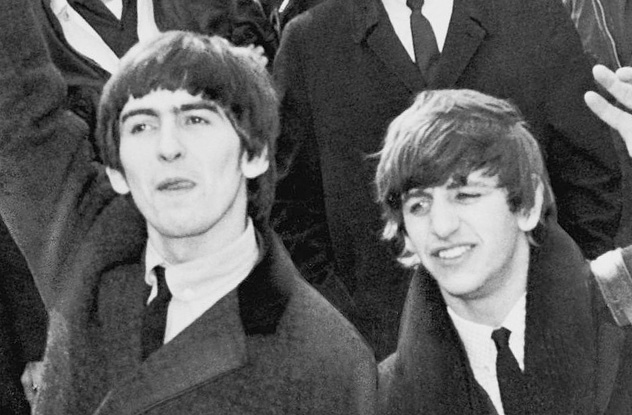
Thanks to a mix of egos and economics, Paul McCartney left The Beatles in April 1970, ending the most famous musical act in history. But Paul wasn’t the first member to leave the band. That honor goes to Ringo Starr, who quit back in 1968 while The Beatles were recording their famous The White Album.
In addition to its influence on Charles Manson, The White Album marked a particularly dark period for The Beatles. George was trying to assert himself musically, Paul was becoming rather bossy, and John kept bringing Yoko Ono into the studio, which threw off the band’s groove. As a result, there was a lot of fighting, resulting in band members recording by themselves. In the words of Paul, the White Album was actually the “tension album.”
That tension boiled over on August 22, 1968, when Ringo called it quits. Everyone was fighting, Paul had mocked his drumming, and he was feeling like an outsider. Frustrated, Ringo approached John and said, “I’m leaving the group because I’m not playing well, and I feel unloved and out of it, and you three are really close.” Lennon was flabbergasted. “I thought it was you three!” he shouted. When Ringo approached Paul, he got the same exact response.
Nevertheless, Starr borrowed Peter Sellers’s yacht, sailed for Sardinia, and spent two weeks on the high sea writing “Octopus’s Garden.” In the meantime, Paul filled in for Ringo, drumming on “Back in the USSR” and “Dear Prudence.” But eventually, the band sent Ringo a telegram proclaiming him the best drummer in the world and begging him to come back. And when Starr returned, he found flowers spread across his drum set, spelling out the words, “Welcome Back, Ringo.”
The good mood didn’t last. In 1969, George was getting angry at Paul for suppressing his songs and was furious at Lennon for taking Yoko’s advice over his. It also didn’t help that a documentary crew was filming every little flare-up. Finally, things exploded when Lennon told the press that Apple was going bankrupt. An enraged George confronted John, and the two ended up getting into an actual fistfight. Sick of all the shenanigans, Harrison decided it was time to go.
“See you ‘round the clubs,” he said as he stormed off. Lennon, always one to add fuel to the fire, made a joke about replacing George with Eric Clapton.
The four were able to smooth things over for a little while, and George returned to finish Let It Be and Abbey Road. Sadly, though, time was running out for The Beatles, and in just a matter of months, the dream would finally be over.
Nolan Moore was killed in a car crash, but then he was replaced by a look-alike. If you want to keep up with Nolan’s writing, you can friend/follow him on Facebook. You can also email him here.
